Chapter Four
Dangerous Concept, Dangerous Times - Galileo, Kepler and the Church: The Prince Astronomer, Tycho Brahe
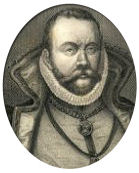
"With a firm and steadfast mind one should hold under all conditions, that everywhere the earth is below and the sky above, and to the energetic man, every region is his fatherland."
— Tycho Brahe, Quoted in A L Mackay, Dictionary of Scientific Quotations (London 1994)
"Men pay heed to an astrologer who contends that it is the earth that moves, and not the heavens or the firmament, the sun and the moon. If a man yearns for a reputation as a profound scientist, he should invent some new system. This madman would subvert the whole science of astronomy; but Scripture tells us that Joshua bade the sun, and not the earth, to stand still."
— Luther's Table-Talk of Astronomy and Astrology [1]
The Prince Astronomer Tycho Brahe, 1546 - 1601 ∫∫∫
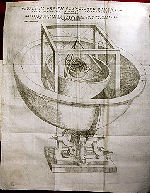 In his book, Mysterium Cosmographicum, Kepler argued that the distances of the planets from the Sun in the Copernican system were determined by the five regular solids, if one supposed that a planet's orbit was circumscribed about one solid and inscribed in another. Though later abandoned, the groundwork for this working model lead to further research and discovery of the "Kepler solids": a realization that the orbits of planets are not just circles, what we today call Kepler's laws of planetary motion though "[e]vidence suggests Kepler believed in the efficacy of this [his own] theory all of his life, that is, it held equal weight with his so-called three laws of planetary motion" Image: Drawing showing the planetary spheres with regular solids, courtesy History of Science Collections, University of Oklahoma Libraries. [2]
In his book, Mysterium Cosmographicum, Kepler argued that the distances of the planets from the Sun in the Copernican system were determined by the five regular solids, if one supposed that a planet's orbit was circumscribed about one solid and inscribed in another. Though later abandoned, the groundwork for this working model lead to further research and discovery of the "Kepler solids": a realization that the orbits of planets are not just circles, what we today call Kepler's laws of planetary motion though "[e]vidence suggests Kepler believed in the efficacy of this [his own] theory all of his life, that is, it held equal weight with his so-called three laws of planetary motion" Image: Drawing showing the planetary spheres with regular solids, courtesy History of Science Collections, University of Oklahoma Libraries. [2]Tycho Brahe, who had read Kepler's work, felt it in error and had politely crticised it as such. Still, he saw in this work the brillance of a mathematical mind and so offered Kepler a postion as an assistant. But Tycho's own theory regarding the solar system was itself, convoluted and impractical, based on his own idea of a system that was "an unhappy compromise between Ptolemy and Copernicus" [3]
As it was, in February of 1600, the two finally met and though Tycho would live only another year and eight months, the result of that meeting still shine down upon astronomical science to this day.
"A copy of Mysterium was sent to Tycho Brahe and Galileo Galilei. Galileo wrote him back and said he looked forward to reading the book and that he was also a supporter of Copernicus. Tycho sent him an encouraging reply, but did not believe in the reality of the spheres and their supporting structures as Kepler did. However, Tycho recognized the genius of Kepler's mathematical skills. The future interactions between Kepler and Tycho greatly influenced Kepler's life and modern astronomy." [4]
Those "interactions" were, without a doubt, one of astronomy's most effective, though never the single minded effort one might think. For while Tycho and Kepler truely had need of each other's talents and resources, both had far different ideas and agendas as to what each wanted from the other and while the collaboration would bear fruit, it would also be the direct cause of the consternation and friction both great thinkers would develope towards one another over the next year. Tycho Brahe, the early years ∫∫∫
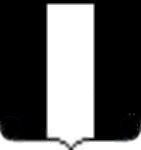 Tyge Ottesen Brahe was born on December 14, 1546; the Latinization of his name, adopted by himself at age 15, resulting in the more familiar Tycho [5]. He entered the world at Knutstorp in Scania ( in modern-day Sweden ) where "he was born between nine and ten o'clock in the morning" as the first-born son of Otte Brahe and Beate Bille. Nor was he born alone, for his mother had given birth to twins, but the second child died shortly after birth; Tycho would later write a Latin ode to his deceased brother which was printed as his first publication in 1572 [6] The family into which he was born were some of the most known and influential nobles in Denmark, the Brahe and Bille families, and it was his noble right by birth to carry a sword, a fact which later gave rise to an incident for which Tycho is also historically famous for, the partial loss of his nose. [7] Image: Tycho's coat-of-arms, The crest is actually adorned with a peacock feather between two horns Sable a fess Argent, each bearing four peacock feathers [fesswise]. From Escutcheons of Science - Armorial of Scientists - Numericana © 2000-2009, Gérard P. Michon [8]
Tyge Ottesen Brahe was born on December 14, 1546; the Latinization of his name, adopted by himself at age 15, resulting in the more familiar Tycho [5]. He entered the world at Knutstorp in Scania ( in modern-day Sweden ) where "he was born between nine and ten o'clock in the morning" as the first-born son of Otte Brahe and Beate Bille. Nor was he born alone, for his mother had given birth to twins, but the second child died shortly after birth; Tycho would later write a Latin ode to his deceased brother which was printed as his first publication in 1572 [6] The family into which he was born were some of the most known and influential nobles in Denmark, the Brahe and Bille families, and it was his noble right by birth to carry a sword, a fact which later gave rise to an incident for which Tycho is also historically famous for, the partial loss of his nose. [7] Image: Tycho's coat-of-arms, The crest is actually adorned with a peacock feather between two horns Sable a fess Argent, each bearing four peacock feathers [fesswise]. From Escutcheons of Science - Armorial of Scientists - Numericana © 2000-2009, Gérard P. Michon [8]The science of astronomy was not the chosen discipline for Tycho. He, like other young nobles of his day, began a Latin education which was to be followed until he was 12 years old. That choice however, was made by his uncle, not his father. In a strange incident that seems to have stemmed from an earlier family agreement, and which resulted in outright kidnapping, Tycho was quickly and quietly "taken" away from his parents by his uncle, a Danish nobleman named Jørgen Brahe:
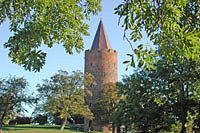 'Tycho later wrote that when he was around two, his uncle, Danish nobleman Jørgen Brahe, "... without the knowledge of my parents took me away with him while I was in my earliest youth." Apparently this did not lead to any disputes nor did his parents attempt to get him back. Tycho lived with his childless uncle and aunt, Jørgen Brahe and Inger Oxe, in the Tostrup Castle until he was six years old. Around 1552 his uncle was given the command of Vordingborg Castle to which they moved, and where Tycho began a Latin education until he was 12 years old. Image: Vordingborg Castle [9] fn1
'Tycho later wrote that when he was around two, his uncle, Danish nobleman Jørgen Brahe, "... without the knowledge of my parents took me away with him while I was in my earliest youth." Apparently this did not lead to any disputes nor did his parents attempt to get him back. Tycho lived with his childless uncle and aunt, Jørgen Brahe and Inger Oxe, in the Tostrup Castle until he was six years old. Around 1552 his uncle was given the command of Vordingborg Castle to which they moved, and where Tycho began a Latin education until he was 12 years old. Image: Vordingborg Castle [9] fn1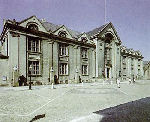 In April of 1559, Tycho began his studies at the University of Copenhagen. His enrollment there was for the study of jurisprudence, philosophy and rhetoric, the preferred education for those whose career would eventually take them into the courts of nobility. But events, and one in particular, would transpire to change this career path, much to the chagrin of his family and uncle — though one might say, happily for science — for at the end of August, 1560 there occured in the skies of Europe a partial solar eclipse. Image: University of Copenhagen
In April of 1559, Tycho began his studies at the University of Copenhagen. His enrollment there was for the study of jurisprudence, philosophy and rhetoric, the preferred education for those whose career would eventually take them into the courts of nobility. But events, and one in particular, would transpire to change this career path, much to the chagrin of his family and uncle — though one might say, happily for science — for at the end of August, 1560 there occured in the skies of Europe a partial solar eclipse. Image: University of CopenhagenIn his article, Tycho Brahe — A King Amongst Astronomers respected author and scholar David Plant notes,
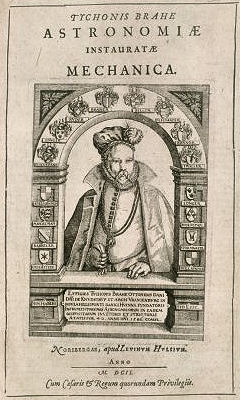 "The solar eclipse of 31st August 1560 at 7° Virgo 51' was total in the extreme west of Europe. At Copenhagen it was partial but still attracted Tycho's attention. Astrology was an everyday topic of conversation amongst his fellow students and Tycho's interest was aroused. When he saw the eclipse take place at the predicted time, it struck him as miraculous that the motions of the planets could be forecast so accurately. He immediately acquired an ephemeris and the complete works of Ptolemy and set about learning how it was done.
"The solar eclipse of 31st August 1560 at 7° Virgo 51' was total in the extreme west of Europe. At Copenhagen it was partial but still attracted Tycho's attention. Astrology was an everyday topic of conversation amongst his fellow students and Tycho's interest was aroused. When he saw the eclipse take place at the predicted time, it struck him as miraculous that the motions of the planets could be forecast so accurately. He immediately acquired an ephemeris and the complete works of Ptolemy and set about learning how it was done.Jörgen Brahe disapproved of Tycho's new passion. He regarded stargazing as a vulgar pursuit far beneath the dignity of a Danish nobleman. Determined that Tycho should continue the family tradition of service to the state, Jörgen packed him off to study law at Leipzig University under the supervision of a tutor, Anders Vedel, who had strict instructions to ensure that Tycho attended to his proper studies. But by then it was too late. Showing little interest in law or statecraft, Tycho continued to study astronomy in secret, making observations when Vedel was asleep and somehow contriving to spend most of his allowance on books and instruments. Vedel eventually gave way to Tycho's persistence and turned a blind eye to his extra-curricular activities, after which they became good friends." [10] Image: From the book Tychonis Brahe Astronomiae instauratae mechanica showing author's portrait within an architectural design that incorporates the coat of arms of his ancestors. [11] fn2
By late 1560 Tycho Brahe had firmly emmersed himself into the study of astronomy and the more he read, the more he realized just how inaccurate and unorganized the data being relied upon and taught was; some of it to an extremely large degree of error. By 1563, at the age of 17, having read and studied such works as Sacrobosco's Tractatus de Sphaera, Apianus's Cosmographia seu descriptio totius orbis and Regiomontanus's De triangulis omnimodis his intelligence and understanding of the science was sharp enough to write,
"I've studied all available charts of the planets and stars and none of them match the others. There are just as many measurements and methods as there are astronomers and all of them disagree. What's needed is a long term project with the aim of mapping the heavens conducted from a single location over a period of several years." [12]
Few are those that by design or chance, more accurately map out the exact course the rest of their life will take. So it is only the more remarkable that Tycho, investing a little more than a few years — the rest of his life — would pursued exactly what he had written as a teenager of just 17 years. Tycho Brahe & the University of Leipzig ∫∫∫
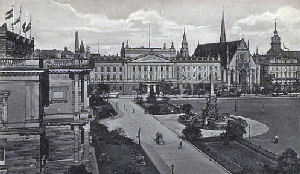 In March of 1562 Tycho Brahe walked through the doors of Leipzig University, a student of law, as his uncle had wished. With him was priest, historian and tutor Anders Sørensen Vedel. But in 1595 he walked out of Leipzig an astronomer — what had happened? fn3
In March of 1562 Tycho Brahe walked through the doors of Leipzig University, a student of law, as his uncle had wished. With him was priest, historian and tutor Anders Sørensen Vedel. But in 1595 he walked out of Leipzig an astronomer — what had happened? fn3Image: Seen prior to WWI is Leipzig University on the Augustusplatz, c.1910-12 from a scan of an old postcard in the author's collection.
After the solar eclipse of August 1560, Tycho became more interested than ever in the study of astronomy and so decided to pursure the science no matter what. This did not, as previously mentioned, endear him to his uncle or family as this interest was not an acceptable educational path befitting his status. With this in mind, Tycho had been sent to Leipzig in the company of Vedel who's job it was to see to his "proper" education in law. Notes J. L. E. Dreyer in his definitive work Tycho Brahe: A Picture of Scientific Life and Work in the Sixteenth Century:
"Vedel did his best to carry out his instructions by trying to keep Tycho to the study of jurisprudence, but Tycho would not allow himself to be hindered in his favorite pursuits, and spent most of his money on astronomical books and instruments, though he had to receive the money from his tutor and account to him for the way it was spent." [13]
Try as he might, Vedel proved unequal to the task of keeping Tycho at his law studies — he was now too far invovled in his astronomical pursuits, too determined to travel that path he already foresaw as necessary. Vedel had no choice but to acquiesce to the stubborn Tycho ( they would remain warm, lifelong friends however ) and so it was that, in August of 1563, Tycho made his first recorded observation, listed in his protocol of Mars, also witnessesing the predicted conjunction between Saturn and Jupiter. Tycho was captivated, marveling that men could predict the divine movements of planets within the firmament. It was also the same month that Tycho made the discovery that set him upon the quest of a lifetime: in studying the charts which, amongst other things, predicted the conjunction of the two planets, he found "that the Alfonsine tables were off by a month in predicting this event, and the Copernicus tables off by several days." [14]
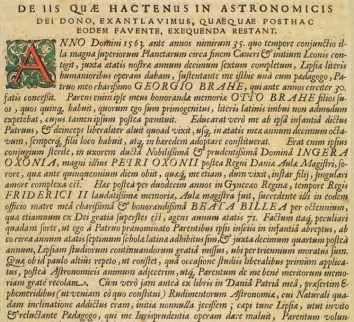 Resolved to set things right himself, Tycho constructed his first instrument in 1564, a radie or pair of calipers made of wood, based and designed on the directions that had been given by Gemma Frisius. In order for these to be functional, he needed them to have lines of degree for meansurement set in them. Writes Tycho, "Later on, in the year 1564, I secretly had a wooden astronomical radius made according to the direction of Gemma Frisius. This instrument was provided with an accurate division utilizing transversal points by Bartholomæus Scultetus, who at the time lived in Leipzig, and with whom I was on intimate terms on account of our mutual interests." Image: First page of Tycho Brahe's autobiography from "Mecanica" [15]
Resolved to set things right himself, Tycho constructed his first instrument in 1564, a radie or pair of calipers made of wood, based and designed on the directions that had been given by Gemma Frisius. In order for these to be functional, he needed them to have lines of degree for meansurement set in them. Writes Tycho, "Later on, in the year 1564, I secretly had a wooden astronomical radius made according to the direction of Gemma Frisius. This instrument was provided with an accurate division utilizing transversal points by Bartholomæus Scultetus, who at the time lived in Leipzig, and with whom I was on intimate terms on account of our mutual interests." Image: First page of Tycho Brahe's autobiography from "Mecanica" [15]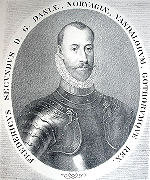 Meanwhile, events in 1565 required Tycho to leave Leipzig University. In that year his Uncle, Jørgen Brahe, had developed pneumonia shortly after saving King Frederick II from drowning in one of the canals in Copenhagen. This incident occurred during Denmark's war with Sweden, know as the Scandinavian Seven Years' War. The war eventually ended in a stalemate, neither side gainning anything but a few bloody deeds and many dead. [16] Image: Frederick II of Denmark & Norway
Meanwhile, events in 1565 required Tycho to leave Leipzig University. In that year his Uncle, Jørgen Brahe, had developed pneumonia shortly after saving King Frederick II from drowning in one of the canals in Copenhagen. This incident occurred during Denmark's war with Sweden, know as the Scandinavian Seven Years' War. The war eventually ended in a stalemate, neither side gainning anything but a few bloody deeds and many dead. [16] Image: Frederick II of Denmark & Norway"the uncle died of pneumonia after rescuing the king from drowning after the king had fallen off the bridge to his castle returning from a naval battle with the Swedes. When Tycho returned to Denmark, the rest of his family were quite unfriendly. They despised his stargazing, and blamed him for neglecting the law. He decided to return to Germany, and fell in with some rich amateur astronomers in Augsburg. He persuaded them that what was needed was accurate observation, and (as telescopes had not yet been invented) this meant rather large quadrants to get lines of sight on stars. They set up a large wooden quadrant, part of a circle with a nineteen foot radius, that took twenty men to set up. It was graduated in sixtieths of a degree. This was the beginning of Tycho's accurate observations." — Michael Fowler, Tycho Brahe
It was also the year that one of his more memorable charatcter traits would reveal itself — his temper. The results would supply history with another small and famous paragraph in the life of Tycho Brahe, but unlike all others, it was not in the science of astronomy but in the scoical and interpersonal violence involving men described as nobel or gentlemen — the duel.
Next Page »
Chapter Four of Galileo, Kepler and the Church — The Prince Astronomer Tycho Brahe, Page 7
Footnotes
1. The stories of just how Jørgen Brahe obtained custody of Tycho are several. Tycho's own version is that it was "without the knowledge of my parents", and simply presented as a fait accompli ( see: His autobiography from "Mecanica" Rundetaarn Observatory web site ). Other sources state that his father had made an agreement before he was born, and if Brahe was a boy, the uncle could raise him. The death of the twin son perhaps made this untenable, his father quietly forgetting his promise. This does seem consistent with Tycho's own writing in which no mention or knowledge of the arrangement is made. The details of the arrangement would probably have made for a very unconfortable "father-and-son talk" ( see: New World Encyclopedia ) Michael Fowler, in his on-line lecture of Tycho Brahe also notes this, adding that Tycho's father "...changed his mind and reneged. Then, when a younger brother was born, the uncle kidnapped Tycho. The father threatened to murder the uncle, but eventually calmed down, since Tycho stood to inherit a large estate from the uncle." ( see: Tycho Brahe Copyright © Michael Fowler 1996 ) However accomplished it "was a strange episode since it did not appear to cause any family disputes nor did his parents try to take him back." ( from the article by J J O'Connor and E F Robertson School of Mathematics and Statistics University of St Andrews, Scotland JOC/EFR © April 2003 )
2. I have been unable to ascertain whether or not Tycho saw the eclispe of 1560, his autobiography, "Mecanica" remains silent on this point. In their time line, the rundetaarn.dk (Round Tower Observatory) website notes that "a partial solar eclipse occurs which, depending on the weather, would have been visible in Copenhagen; whether Tycho saw it or not we do not know, for he never mentions it in his writings." Rundetaarn Observatory website. In Dreyer's technical biography on Tycho, he notes that "Though it was only a small eclipse at Copenhagen, it attracted the special attention of the youthful student..." wherein he references French philosopher and scientific chronicler Pierre Gassendi (January 22, 1592 October 24, 1655) p.5, though Gassendi had not written from personal knowledge, see J. L. E. Dreyer's Tycho Brahe..., p.13. There is no doubt that Tycho's interest in astronomy was very much alive at this time for he purchased his first astronomy book during this period which is today located in the castle of Kronborg Library. [ibid].
3. Anders Sørensen Vedel, in addition to being Tycho's tutor, was later reccognized for his ability as a poet based on a surviving text he wrote regarding Danish ballads. This volume was one of a handful of records and volumes that survived the fires of Copenhagen in 1728, a conflagration that destroyed the University of Copenhagen's library, along with many other irreplacable works of art, science, history, official records, several notable private collections and much of the observatory on top of Rundetårn. The destruction from the fire included the instruments and records of Tycho Brahe. The loss of all the early histroical records and cultural knowledge is still felt to this day. For more information see Copenhagen Fire of 1728 at Wikipedia For additional historical background between Tycho Brahe and Anders Sørensen Vedel see Gangleri — articles, The Northern tradition in the Renaissance which focuses on the traditions of the Northern Euorpean esoteric Renaissance period, providing some well researched information not usually included in historical works on Tycho Brahe.












Chapter Four Bibliography
[1] Sewell, Kathy — from THE TABLE-TALK OF MARTIN LUTHER, TRANSLATED BY WILLIAM HAZLITT, Esq. Philadelphia: The Lutheran Publication Society, June 1, 1997 This book is in the public domain.
[2] Hatch, Dr Robert A. Kepler's Five Regular Solids, © 1999 Dr Robert A. Hatch - University of Florida
[3] Salling, J. R. The Collected Noses of Tycho Brahe, © 2009 Word Riot
[4] Wilson, John Wm. Johannes Kepler (1571-1630) Department of Physics and Astronomy Georgia State University, 20 November 2001.
[5] Tycho Brahe from Wikipedia — Revision history
[6] Tycho Brahe - encyclopedia article - Citizendium Article is quoting Wittendorff, ALex. 1994. Tyge Brahe. Copenhagen: G. E. C. Gad. The article is available under the Creative Commons-Attribution-ShareAlike 3.0 Unported license
[7] Curriculum vitae of Tycho Brahe from the Rundetaarn observatory website. RUNDETAARN Koebmagergade 52a DK-1150 Copenhagen Denmark
[8] Escutcheons of Science, Copyright © 2003-2009 by Gérard P. Michon, Ph.D. from the Escutcheons of Science - Armorial of Scientists - Numericana website, page Coat of arms of Tycho Brahe
[9] Tycho Brahe: Biography from Answers.com Wikipedia. This article is licensed under the GNU Free Documentation License. It uses material from the Wikipedia article "Tycho Brahe".
[10] Plant, David Skyscript: Tycho Brahe - A King Amongst Astronomers © by David Plant, This article was first published in The Traditional Astrologer Magazine, published by Ascella Publications, Issue 8, Spring 1995. Reprinting is by the kind permission of David Plant
[11] Smithsonian Institution Libraries Digital Edition, 1999 ASTROMOMIÆ INSTAURATÆ MECHANICA first published in Wandsbeck, 1598. Call number: q QB85 .B7 1602 Dibner Library of the History of Science and Technology
[12] Knuth, Kevin H. Physics 112, Star Systems Lecture 5 Telescopes and Spectrometers by Kevin H Knuth University at Albany Spring 2007. File is in .pdf format.
[13] Dreyer, J. L. E. Tycho Brahe: A Picture of Scientific Life and Work in the Sixteenth Century The on line publication was made available through the Google.com on line books interface, June 7, 2009, ISBN: 076618529X, version: orig. pub. EDINBURGH: ADAM AND CHARLES BLACK 1890. Also available online at the The Internet Archive website
[14] Fowler, Michael Tycho Brahe, University of Virginia Physics, lecture notes from Physics 109, Galileo and Einstein, copyright © Michael Fowler 1996 except where otherwise noted, updated 2008. June 07, 2009.
[15] Tycho Brahe's autobiography DE IIS QUÆ HACTENUS IN ASTRONOMICIS DEI DONO, EXANTLAVIMUS, QUEQUE POSTHAC EODEM FAVENTE, EXEQUENDA RESTANT, this is his autobiography from "Mecanica" Translation and above image from the RUNDETAARN observatory website, Koebmagergade 52a DK-1150 Copenhagen. June 7, 2009
[16] Rickard, J. 24 July 2007 Nordic Seven Years War, 1563-1570, from the historyofwar.org website, June 08, 2009
Right Side Image Credits:
Unless otherwise noted images displayed on the right side of page and credited as ImgBibCC are from
[17] BibliOdyssey: Tycho Mechanica Friday, February 24, 2006, Creative Commons 2.5 Usage License & Terms All images credited as "ImgBibCC" are from the BibliOdyssey: Tycho Mechanica web page and reproduced here under the Creative Commons 2.5 terms above. Excluding the resizing of images, they have been posted here in their original format. Copyright and other restrictions may apply.
17th Century Telescope & The Year of Astronomy 2009

Celebrating 400 Years of Astronomy! US Node
Universe Awareness for Young Children A International Outreach Program for Children
400 Years of Astronomy Worldwide National Node
You can:
Close Window
Back To Main Page
Back One Page
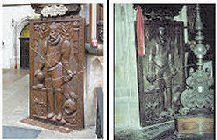
Losing part of his nose in a rapier duel, he was said to have worn a realistic replacement made of silver and gold, using a paste to keep it attached. Some people, such as Fredric Ihren and Cecil Adams have suggested that the false nose also had copper. Ihren wrote that when Tycho's tomb was opened in 24 June 1901 green marks were found on his skull, suggesting copper. Cecil Adams also mentions this green colouring which was noted by the medical experts who examined the remains.
Tycho Brahe spent much of his life compiling the world's first truly accurate and complete set of astronomical tables and his work is only the more remarkable as he did so before the invention of the telescope! Brahe's assistant, Johannes Kepler, later used the tables to deduce the laws of planetary motion. In 1628 Kepler published the Rudolphine Tables, a list of remarkably accurate logarithmic astronomical tables based on Brahe's observations and Kepler's subsequent analysis. Above are two views of the tomb of Tycho Brahe at Tyn. Credit: Petr Hadrava
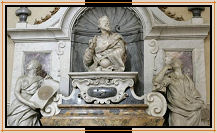
Interestingly, both Tycho and Galileo have recently reappeared in the news: Scientists wish to solve the riddle of Galileo's mistakes using DNA testing ( Source ) "The Italian astronomer -- who built on the work of predecessor Nicolaus Copernicus to develop modern astronomy with the sun as the centre of the universe -- had a degenerative eye disease that eventually left him blind." [ ibid ]
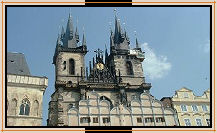
And experts from Denmark have asked the authorities for permission to open and explore the grave of the Danish-born astronomer Tycho Brahe in an attempt to solve the mystery sourrounding his death [ From current events in the Czech Republic Radio Prague ]
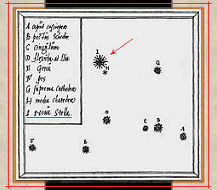
In the evening of the 11th of November 1572, Tycho Brahe for the first time sees a new star in the constellation Cassiopeia. After careful observation he publishes his findings about this "new star" or Stella Nova in Latin. Above is his own drawing of Cassiopeia, with the position of the new star/supernova ( red arrow ) shown, the "Nova Stella" marked as "I". [ Credit: Tycho Brahe's Observations ]
The instruments of Tycho Brahe [17]
"The instruments were built by Tycho Brahe and his staff between the 1570's and his death in 1601, many of them during his stay on the island of Hven (between 1576 and 1597). All of Tycho Brahe's instruments are lost. After his death they were kept in a cellar, where they were destroyed during the uprisings in Prague in 1619." From Astronomiæ instauratæ mechanica Tycho Brahes astronomical instruments Website of The Royal Library, Copenhagen

Sextans Chalybeus Pro Distantiis Per Unicum Obeservatrem Dimetiendis Steel sextant for measuring distances by one single observer Credit: ImgBibCC
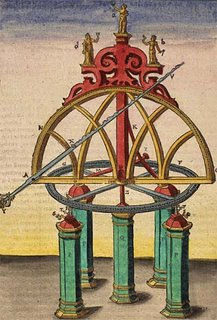
Semicirculus Magnus Azimuthalis Great semicircular azimuth Credit: ImgBibCC
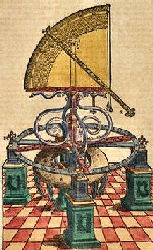
Quadrans Mediocsis Orichalcicus Azimuthalis Medium sized Azimuth quadrant of brass Credit: ImgBibCC
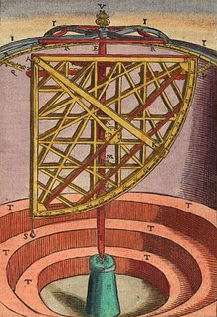
Quadrans Volubilis Revolving azimuth quadrant Credit: ImgBibCC
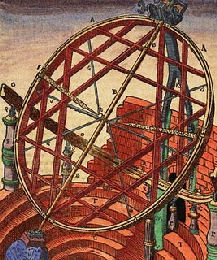
Armilae Aeqatoriæ Maximæ Sesquialtero Constantes Circulo The great equatorial armillary instrument with one complete circle, and one semicircle Credit: ImgBibCC
Reference Sources of Interest —

Bojan Pancevski in Vienna Hamlet may have poisoned stargazer Tycho Brahe in mercury murder From the TimesOnLine website

Tynsky Chram
One of Prague's most easily-recognizeable landmarks, Tyn Cathedral also houses the tomb of Tycho Brahe, the Danish astronomer who died under mysterious circumstances while in the services of Emperor Rudolph II in 1601.

The Collected Noses of Tycho Brahe by J. R. Salling This short, one page article is a very interesting, humorous and fresh aside on the demise of Tycho's nose; well worth the reading.

Galileo's Instruments of Credit Telescopes, Images, Secrecy Introduction From Brass Instruments to Textual Supplemnts [Copyrighted material published on the internet is currently under fair use notice with exceptions] This is an excellent writing from Mario Biagioli's book

The Galileo Project An excellent study source on Galileo, Kepler, Tycho and other eariler astronomers and scientists
You can:
2. Step Back One Page
3. Jump to the Index Page
4. See Galaxies
5. Read About Stars
6. Return to the Top of this Page